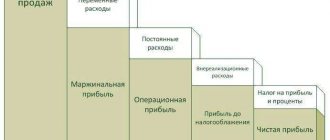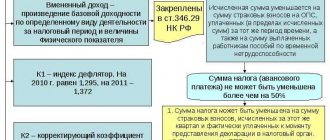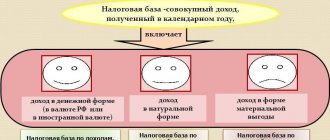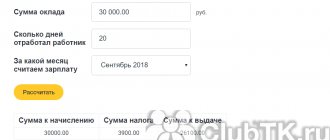Taxable income
In accordance with the law, the following income of an organization is subject to income tax:
- income received from the sale of goods, works, services. In this case, it does not matter whether these are purchased goods or goods of own production.
- non-operating income, such as:
- profit from previous reporting periods identified in the current reporting year;
- positive amount differences;
- positive exchange rate differences;
- property received free of charge;
- penalties and fines;
- written off accounts payable;
- interest on bills and commercial loans;
- interest received on loans;
- dividends;
- the cost of valuables identified during inventories or received after the liquidation of fixed assets, etc.
Concept and main aspects of the tax base
According to the requirements of the Tax Code of the Russian Federation, the tax base is both the cost and physical characteristics of the object subject to tax.
In other words, this concept means any object that is subject to taxation.
The conditions, principles and procedure for establishing the tax base are regulated by relevant regulations, in particular the Tax Code of the Russian Federation.
For example, the tax base for VAT is the total cost of products sold, for personal income tax - income received by an individual, for inheritance tax - the value of inherited property, for gift tax - the value of a gift.
So, the tax base (NB) is:
- one of the main elements of the tax, on the basis of which its amount is calculated;
- a specific object from which tax is collected in the manner prescribed by the Tax Code of the Russian Federation;
- a certain amount on the basis of which the amount of tax is calculated in accordance with the established rate;
- income of a person on which taxes and fees must be paid.
Determination of the tax base is required to quantify the object of taxation.
A specific tax base is applied to each specific tax. For example, for VAT, NB is calculated in accordance with the specifics of the sale of products or purchased goods.
Tax-free income
The list of income not subject to income tax is given in Article 251 of the Tax Code of the Russian Federation and is final.
Not subject to taxation:
- prepayment made for goods when the accrual method is used;
- borrowed funds received;
- the value of property contributed as a contribution to the authorized capital;
- the value of property or funds received by the organization in connection with the fulfillment of obligations under the agency agreement, with the exception of the intermediary’s own remuneration;
- grants and targeted funding;
- the cost of inseparable improvements to fixed assets provided under a free use agreement;
- the cost of inseparable improvements to the leased property made by the lessee.
Also, property received free of charge is not subject to taxation:
- from an individual, provided that the person’s share in the authorized capital of the organization is more than 50%;
- from a legal entity, provided that its share in the authorized capital of the recipient is more than 50%;
- from another organization, provided that the recipient’s share in its authorized capital is more than 50%.
If the listed property was transferred for use or ownership to third parties during the year, income tax must be paid in accordance with the general procedure.
Article 315 of the Tax Code of the Russian Federation. The procedure for calculating the tax base (current version)
Article 315 of the Tax Code of the Russian Federation establishes the procedure for calculating the tax base for income tax, which should reflect the amount of income and expenses from sales, including from the sale of securities; the amount of non-operating income and expenses, including transactions with financial instruments of futures transactions. Based on these data, profit (loss) and the tax base for the reporting (tax) period are formed. To determine the amount of profit subject to taxation, the amount of loss subject to transfer in the manner prescribed by Article 283 of the Tax Code of the Russian Federation is excluded from the tax base.
The Presidium of the Supreme Arbitration Court of the Russian Federation, in Resolution No. 14955/08 dated March 17, 2009, explained that the legislation on taxes and fees provides for a separate formation of the tax base for income tax on income from activities taxed at a rate of 24 percent, and income received in the form of interest on debt obligations taxed at different rates. The possibility of adjusting the tax base for income tax, formed according to the rules of Article 315 of the Tax Code of the Russian Federation, for income taxed at other rates, the tax base for which is formed separately, is not provided for by this article of the Tax Code of the Russian Federation.
Article 283 of the Tax Code of the Russian Federation also does not contain provisions allowing to reduce the amount of carry-forward losses from activities taxed at a rate of 24 percent by profit (income) from other types of activities taxed at other rates according to a separately formed tax base, from which the tax was paid in the established amount. The Tax Code of the Russian Federation is in order.
The formulated approaches are used in judicial practice.
Thus, the Resolution of the Federal Antimonopoly Service of the Moscow District dated January 13, 2010 N KA-A40/14808-09 states that the taxpayer legally determined the loss for core activities for 2007 without taking into account income received in the form of dividends, the tax base for which was formed separately and the tax from which paid at a rate of 9 percent.
Attention!
The Resolution of the Presidium of the Supreme Arbitration Court of the Russian Federation dated February 26, 2008 N 14908/07 states that the Tax Code of the Russian Federation establishes a restriction regarding the accounting for tax purposes of losses received by a taxpayer from transactions involving the sale of securities, both traded and non-traded on the organized securities market.
The Tax Code of the Russian Federation does not contain such a restriction regarding the possibility of reducing income received from transactions with securities by the amount of loss from the main type of activity.
According to the Presidium of the Supreme Arbitration Court of the Russian Federation, this conclusion follows from the content of Article 315 of the Tax Code of the Russian Federation, according to which the calculation of the tax base for calculating income tax includes proceeds from the sale of securities and expenses incurred during their sale. To determine the amount of profit subject to taxation, only the amount of loss, in particular from transactions with securities, subject to transfer in the manner prescribed by Article 283 of the Tax Code of the Russian Federation, is excluded from the tax base.
The Federal Antimonopoly Service of the North-Western District, in Resolution No. A56-83514/2009 dated August 23, 2010, states that the Tax Code of the Russian Federation itself has established a restriction according to which, when determining the tax base, profit from core activities cannot be reduced by the amount of loss received from operations with securities.
Attention!
It should be noted that the calculation of the tax base for the reporting (tax) period is compiled by the taxpayer independently in accordance with the standards established by Chapter 25 of the Tax Code of the Russian Federation, based on tax accounting data on an accrual basis from the beginning of the year.
In this case, only accounting data is not used for the purposes of calculating the tax base.
Judicial practice confirms this position.
The Federal Antimonopoly Service of the Moscow District, in Resolution No. KA-A40/15877-10-2 dated 02/03/2011, came to the conclusion that the legislation on taxes and fees does not provide for the possibility of determining the value of property based on the accounting value of fixed assets indicated in the separation balance sheet, which is compiled in in accordance with paragraph 4 of Article 58 of the Civil Code of the Russian Federation and paragraph 4 of Article 19 of the Federal Law of December 26, 1995 N 208-FZ “On Joint Stock Companies” for use in corporate legal relations.
According to the court, data from separation balance sheets on the cost of fixed assets according to accounting data compiled by organizations affiliated with the taxpayer cannot form for him the initial cost of fixed assets for tax accounting purposes.
Thus, as the court noted, when determining the initial value of property received during reorganization, the taxpayer, for the purpose of calculating income tax, is obliged to be guided by Articles 257, 313, 315 of the Tax Code of the Russian Federation, as well as tax accounting data for the value of the transferred property specified in the acceptance and transfer acts signed during the reorganization.
Comment source:
“ARTICLE-BY-ARTICLE COMMENTARY TO CHAPTER 25 OF THE TAX CODE OF THE RUSSIAN FEDERATION “CORPORATE PROFIT TAX” (UPDATED)
Yu.M. Lermontov, 2012
Organizational expenses subject to deduction
- Employee remuneration costs. This group includes:
- wages;
- bonuses;
- compensation;
- additional payments;
- one-time payments for length of service;
- labor costs for employees working under civil contracts;
- insurance payments, both under compulsory and voluntary insurance contracts;
- labor costs for periods of forced temporary downtime;
- accruals for staff reductions or company reorganization;
- funds reserved for the upcoming payment of benefits for length of service and vacation pay;
- employee costs for paying interest on loans for the purchase and construction of housing, etc.
- Material costs
- Depreciation of fixed assets
- Other costs associated with sales and production. Such as:
- rent;
- Third-party company services;
- advertising;
- compensation for the use of personal transport;
- travel and entertainment expenses;
- personnel training;
- insurance;
- rights to use programs and databases for computer equipment.
- Non-operating expenses, which include:
- interest on loans and credits;
- interest on securities;
- legal costs and arbitration fees;
- fines, penalties, penalties for violated terms of contracts;
- shortages of material assets identified during inventories, in the absence of culprits;
- negative exchange rate difference;
- expenses incurred in connection with the formation of a reserve for doubtful debts;
- losses from previous years that were identified in the current tax period;
- written off accounts receivable;
- losses due to force majeure.
Expenses that are not tax deductible
Expenses that are not subject to tax deduction are listed in Article 270 of the Tax Code of the Russian Federation.
Such expenses include:
- contributions of founders to the authorized capital;
- taxes and payments for exceeding limits on emissions of pollutants into the environment;
- penalties and fines transferred to the state budget, as well as state extra-budgetary funds;
- payments and remuneration to members of the board of directors;
- contributions to the reserve in case of depreciation of investments in securities. The exception is the contributions of professional participants in the securities market;
- losses incurred in the process of servicing production and farming. This list includes objects of both socio-cultural and housing and communal services;
- prepayment made for the goods, in case of using the accrual method;
- property and funds transferred under loans and loan agreements;
- voluntary membership fees to public organizations;
- the value of property transferred free of charge. This also includes the cost of transferring such property;
- fee for notary registration when the amount of such fee exceeds the established tariffs;
- the amount of revaluation of securities at market value in case of a negative difference;
- bonuses paid from earmarked proceeds or special-purpose funds;
- partial or full repayment of loans provided to employees for housing;
- lump sum payments for retirement , as well as pension supplements;
- payment for vacations not provided for by current legislation, but provided for by the collective agreement;
- vacation and treatment vouchers for employees;
- visiting cultural and sporting events;
- n subscription to literature not used for production purposes;
- payment for travel from home to the place of work and back, if such payment is not provided for by the provisions of the collective agreement or technological features of production;
- preferential or free meals in cases where it is not provided for by the provisions of the collective agreement or current legislation;
- payment for personal consumption goods and similar expenses made in favor of the employee.
Section on document restoration - how to restore a pension insurance certificate.
In the news (here) about how to restore a lost driver's license.
How to register an inheritance for a house? https://urist.club/inheritance/coming_into/kak-oformit-nasledstvo.html
Profit tax amount
The tax rate for income tax for organizations under current legislation is 20%. Of this, 2% goes to the federal budget, and 18% goes to the regional budget.
This tax rate applies to residents of the Russian Federation.
For foreign organizations, if they do not have a permanent establishment in the Russian Federation, the amount of income tax is 20% on all income and 10% on the use or delivery of vehicles for international transport.
Example of calculation procedure
Manufacturing organization X took out a loan of 1 million rubles in the current reporting period, and made an initial payment of 400 thousand rubles.
Amounts on loans and advance contributions in this case are not subject to taxation.
In the first quarter of the year, the organization received revenue of 1,770 thousand rubles, including VAT of 270 thousand rubles.
Production costs amounted to 560 thousand rubles. Staff salaries are 350 thousand rubles.
Insurance contributions from wages - 91 thousand rubles. Depreciation of equipment - 60 thousand rubles.
Interest on a loan issued to another company and taken into account for tax purposes for the first quarter amounted to 25 thousand rubles. We also take into account last year’s tax loss, which amounted to 120 thousand rubles.
Total expenses for the first quarter of the year: 767,700 rubles.
Taxable profit for the first quarter of the year: 612,300 rubles.
1,770,000 (revenue) - 270,000 (VAT) - 767,700 (expenses) - 120,000 (tax loss for last year) = 612,300 rubles.
The amount of income tax will be: 122,460 rubles.
612,300 (profit) x 20% (tax rate) = 122,460 rubles.
the amount of tax going to the federal budget: 612,300 x 2% = 12,246 rubles.
the amount of tax going to the regional budget: 612,300 x 18% = 110,214 rubles.
Example of tax calculation according to the simplified tax system (object “income”)
Individual entrepreneur Ivanov is engaged in trade in construction materials. He hired two workers. The first salary is 30,000 rubles. per month, the salary of the second is 50,000 rubles. per month.
Advance payment for the first quarter
In the first quarter of 2021, IP Ivanov transferred contributions from employee salaries: in January - for December 2021, in February - for January, in March - for February. Each time, the amount of pension and medical contributions, as well as social insurance contributions in case of temporary disability and in connection with maternity, amounted to 24,000 rubles ((30,000 rubles + 50,000 rubles) × 30%), the amount of contributions “for injuries” — 160 rubles ((30,000 rubles + 50,000 rubles) × 0.2%).
In January 2021, Ivanov transferred contributions “for himself” for 2021: pension contributions in the amount of 32,448 rubles, medical contributions in the amount of 8,426 rubles.
Total in the first quarter, individual entrepreneur Ivanov paid insurance premiums totaling 113,354 rubles (((24,000 rubles + 160 rubles) × 3 months) + 32,448 rubles + 8,426 rubles).
In the first quarter of 2021, Ivanov received revenue in the amount of RUB 3,000,000. The advance payment under the simplified tax system of 6% for the first quarter is equal to 180,000 rubles. (RUB 3,000,000 × 6%).
Individual Entrepreneur Ivanov has the right to reduce the advance payment for the first quarter by an amount not exceeding 90,000 rubles (180,000 rubles × 50%). Ivanov transferred 90,000 rubles to the budget, and the rest of the contributions, equal to 23,354 rubles. (113,354 rubles - 90,000 rubles), he will be able to take into account when calculating the advance payment for the six months.
Keep records, prepare and submit reports according to the simplified tax system
Advance payment for half a year
In the second quarter of 2021, IP Ivanov transferred contributions from employee salaries: in April - for March, in May - for April, in June - for May. Each time, the amount of pension and medical contributions, as well as social insurance contributions in case of temporary disability and in connection with maternity, amounted to 24,000 rubles ((30,000 rubles + 50,000 rubles) × 30%), the amount of contributions “for injuries” — 160 rubles ((30,000 rubles + 50,000 rubles) × 0.2%).
In total, in the second quarter, individual entrepreneur Ivanov paid insurance premiums totaling 72,480 rubles ((24,000 rubles + 160 rubles) × 3 months).
In the second quarter of 2021, Ivanov received revenue in the amount of RUB 2,500,000. The advance payment under the simplified tax system of 6% for the six months is 330,000 rubles. ((RUB 3,000,000 + RUB 2,500,000) × 6%). Taking into account the advance payment for the first quarter, the resulting value is equal to 150,000 rubles (330,000 rubles - 180,000 rubles).
Ivanov also has the right to reduce the advance payment for the six months by contributions transferred in the second quarter and by part of the contributions transferred but not taken into account in the first quarter. At the same time, you can reduce the advance payment for six months by an amount not exceeding 75,000 rubles (150,000 rubles × 50%).
Ivanov transferred 75,000 rubles to the budget, and the remaining part of the contributions, equal to 20,834 rubles (23,354 rubles + 72,480 rubles - 75,000 rubles), he can take into account when calculating the advance payment for nine months.
Calculate contributions “for yourself”, tax according to the simplified tax system, fill out payments in the web service Fill out for free
How is income tax calculated?
First you need to calculate the tax base, which is calculated as the difference between the organization's total income, expressed in cash or in kind (OD), and its total expenses (OR). That is, the tax base is the total profit of the enterprise minus expenses for the reporting period.
Total income is the sum of income received as a result of the main and secondary activities of a given organization. Simply put, this is the total profit.
The total expense consists of advertising costs, labor costs, depreciation, production costs, as well as fines, debts, etc.
Also, to calculate income tax, you need to know the tax rate (TS) as a percentage, which since 2015 has been 20%, with rare exceptions (but cannot be lower than 12.5%).
Algorithm for calculating income tax (IP): NP= (OD-OR)*NS/100
The amount obtained as a result of these calculations will be the amount of tax that must be paid.
The procedure for determining the tax base
The basic principles of calculating the tax base (TB), according to which it is determined, are:
- the determination of the tax base is carried out in accordance with tax regulations, in particular the Tax Code of the Russian Federation;
- calculation (determination) of the tax base by tax payers who are legal entities is carried out at the end of the next tax period. The implementation of the procedure is carried out on the basis of information from accounting registers or other documents confirming data on taxable objects;
- If errors and inaccuracies are identified in the calculation of the tax base made in the previous tax period, the tax base and tax amount are recalculated only for the time period in which the violation occurred. If it is impossible to determine the period of commission of the distortion, the recalculation procedure is carried out for the period when the violations were identified;
- Individual entrepreneurs, private notaries, lawyers-founders of law offices determine the National Bank at the end of the next tax period and in accordance with the accounting data of income and expenses, under the conditions and in the manner established by the Ministry of Finance of the Russian Federation;
- tax agents are also required to adhere to the principles and procedure for calculating the tax base established by the Tax Code of the Russian Federation and other special acts of lawmaking.
Declaration and period code
A tax return when calculating income tax is a document filled out by the taxpayer, which reflects information about his main activity, namely:
- the organization's income and expenses;
- tax deductions (refunds) and benefits;
- total tax amount;
- information about objects subject to taxation;
- other data serving as the basis for calculating tax.
A tax return is submitted by each taxpayer for each tax separately. For each tax, the legislation sets its own deadlines for submitting the declaration.
When filling out a tax return, you must indicate the tax period code. The period can be one calendar month, quarter, year or other period of time.
- codes 01-12 correspond to twelve months (01 – for January, etc.);
- codes 21-24 - four quarters;
- code 51 indicates the first quarter upon liquidation of the enterprise; 54 – second quarter; 55 – third; 56 – fourth;
- codes 71-82 correspond to twelve months and are also indicated when liquidating an organization (71 for January, 72 for February, etc.).
Concept, legal characteristics and methods of expressing the tax rate
The concept of a tax rate (TS), as well as the procedure for its calculation, is inextricably linked with the tax base, since, in essence, the TS is the amount of the tax payment on a specifically established object subject to tax.
The tax rate can be expressed in the following forms:
- as a percentage of the size of the tax base. Such examples could be property tax, profit tax, VAT, personal income tax, land tax, etc.;
- in the form of a fixed monetary amount, when each tax unit corresponds to a certain payment amount. For example, most excise taxes, transport fees;
- in a combination of solid and percentage components, so to speak, in a combined form. For example, inheritance tax, gift tax, some types of excise taxes, as well as Unified Social Tax (UST).
The form of expression of the tax rate depends on the method and order of measurement of taxable objects.
Calculation methods
There are two methods for calculating income tax:
- Basically, the accrual method is used. When maintaining tax accounting using this method, all income (expenses) are reflected in the reporting period when they were incurred, regardless of the actual date of receipt of funds. That is, revenue is recognized based on shipment and presentation of settlement documents.
- In some cases, the use of the cash method is permitted, according to which income and expenses are recognized based on the actual accrual of funds.
Recognition of income and expenses
The moment of recognition of income and expenses is the period in which the receipts or expenses taken into account when calculating fees are posted. This is important for calculating income tax for dummies. The moment of recognition directly depends on the method of recognition of income and expenses. There are cash method and accrual method.
If an organization has chosen the cash method, then it must record income when it is immediately received, and expenses when funds are written off. Under the cash method, tax payments are reflected on the days of receipt. write-offs. The cash method cannot be used by banking organizations. The organization has the right to recognize profitability (costs) upon receipt (write-off) in the case where revenue is recorded in the amount of no more than 1 million rubles for each quarter (the last 4 quarters are taken into account). If revenues exceed this threshold, then the company must switch to the accrual method.
Under the accrual method, all income and expenses are recorded in accounting when they arise, and tax payments are reflected on dates confirmed by primary documents. The actual date of payment does not matter.
An institution has the right to annually choose the method of recognizing income and expenses and notify the tax office about this by December 31 of the current year.










